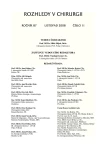-
Medical journals
- Career
Malone Antegrade Continence Enema Stoma in Children with Dysfunctions of Pelvic Organs
Authors: P. Zerhau; M. Husár; J. Tůma
Authors‘ workplace: Klinika dětské chirurgie, ortopedie a traumatologie FN, Brno, přednosta: prof. MUDr. P. Gál, Ph. D.
Published in: Rozhl. Chir., 2008, roč. 87, č. 11, s. 593-595.
Category: Monothematic special - Original
Overview
Introduction:
Regular large intestine cleansing using rectal enemas in patients with impairment of pelvic organs is technically demanding and, frequently insufficient. Defecation is made easier using Malone antegrade continence enema (MACE), which is based on the same principles as continent vesicostomy.Aim:
Assessment of up-to-date experience with the MACE in children.Material and Methodology:
During 2004–2007, the MACE stoma was completed in 7 child patients with spinal dysraphia and severe intestinal dysfunction (meningomyelocele 4x, cerebral palsy 1x, rectal atresia 2x) aged 2–15 y.o.a. In all the subjects, in situ adjusted appendix was used for the construction and, furthermore, continent vesicostomy was performed in two children.Results:
Seven children were followed up for a period of 10–48 months. The enema volume ranged from 100 to 600 ml and it was administered for 20–30 min. The intestine is cleansed within 20–40 minutes. Frequency of the enemas was once daily in 6 patients and every other day in one girl. Complete continence was achieved and obstipation resolved in 5 children, negligible soiling of a diaper lining persisted in 2 subjects. Stenosis of the appendix stoma in two children was managed by its dilation 3 and 5 months postoperatively.Conclusion:
MACE stoma facilitates regular cleansing of the large intestine and subsequent establishment of stool continence in patients with spinal dysraphia, as well as in patients with any intestinal dysfunction, requiring regular administration of enemas. It is safe to be used in patients with concomittant continent stoma of the urinary tract.Key words:
obstipation – stool continence – enema – stoma
Sources
1. Malone, P. S.,Ransley, P. G., Kiely, E. M. Preliminary report: the antegrade continence enema. Lancet, 1990, 336 : 1217.
2. Calado, A. A.,Macedo, A.,Barroso, U., et al. The Macedo-Malone antegrade continence enema procedure : early experience. J. Urol., 2005, 173 : 1340–1344.
3. Liloku, R. B., Mure, P. Y., Braga, L., Basset, T., Mouriquand, P. D. The left Monti-Malone procedure: Preliminary results in seven cases. J. Pediatr. Surg., 2002, 37 : 228–231.
4. Herndon, C. D. A., Cain, M. P., Casale, A. J., Rink, R. C. The colon flap/extension Malone antegrade continence enema: an alternative to the Monti-Malone antegrade continence enema. J. Urol., 2005, 174 : 299–302.
5. Bargawi, A., de Valdenebro, M., Furness, P. D., Koyle, M. A. Lessons learned from stomal complications in children with cutaneous catheterizable continent stomas. BJU Int., 2004, 94 : 1344–1347.
6. Monti, P. R., Lara, R. C., Dutra, M. A., de Carvalho, J. R. New techniques for construction of efferent conduits based on the Mitrofanoff principle. Urology, 1997, 49 : 112.
7. Nanigian, D. K., Kurzrock, E. A. Intermediate-term outcome of the simplified laparoscopic antegrade continence enema procedure: less is better. J. Urol., 2008, 179 : 299–303.
Labels
Surgery Orthopaedics Trauma surgery
Article was published inPerspectives in Surgery

2008 Issue 11-
All articles in this issue
- Minimally Invasive Surgery in the Czech Republic
- The Dependence of Weight Loss on the Dimensions of Neoventriculus in Patients after Gastric Banding
- Biliary Ileus – Potential Complication of Cholecystolithiasis
- Initial Results of the Bipolar RFITT Coagulation in Advanced Stages of Hemorrhoidal Disorder Study
- Operation Treatment of the Humeral Shaft Fractures
- The Use of Biodegradable Materials in the Management of Bone Cysts in Children
- Hybrid Robot-Assisted Surgery, Aorto-Bifemoral Bypass with Reconstruction of Incisional Hernia
- Malone Antegrade Continence Enema Stoma in Children with Dysfunctions of Pelvic Organs
- Therapy of Lymphocele Following Kidney Transplantation
- Outcomes of Transperitoneal Laparoscopic Nephrectomy for Renal Adenocarcinoma
- Proximal Tibial Growth Plate Trauma in Childhood and Options for its Management
- Perspectives in Surgery
- Journal archive
- Current issue
- Online only
- About the journal
Most read in this issue- The Use of Biodegradable Materials in the Management of Bone Cysts in Children
- Biliary Ileus – Potential Complication of Cholecystolithiasis
- Operation Treatment of the Humeral Shaft Fractures
- Minimally Invasive Surgery in the Czech Republic
Login#ADS_BOTTOM_SCRIPTS#Forgotten passwordEnter the email address that you registered with. We will send you instructions on how to set a new password.
- Career

